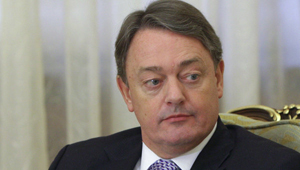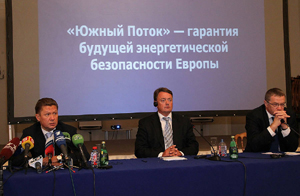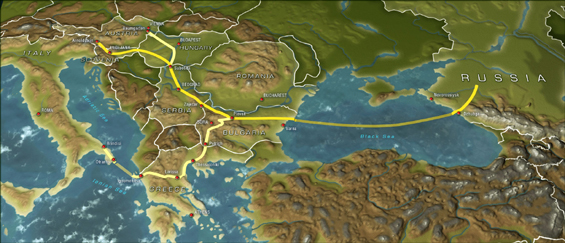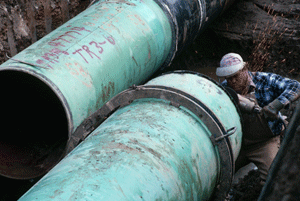'It is the market that will decide whether South Stream will be built'
on
Interview Marcel Kramer, CEO South Stream
‘It is the market that will decide whether South Stream will be built’
In the EU many people believe that the planned South Stream pipeline is a political project by means of which Russia is trying to keep Europe dependent on Russian gas. According to Marcel Kramer, the Dutch CEO of the South Stream consortium, this notion is demonstrably at odds with the facts. In an interview with EER, he points out that most of the gas that will flow through South Stream, is currently flowing through Ukraine to Europe, so the new pipeline will not significantly enhance Russia’s market share. All it will do, Kramer says, is make Russian supplies more secure by providing a new route from Russia to Europe. ‘South Stream is an economic project. It is the market that will decide whether it will be built.’
 |
| 'I do this project because I think it is worth doing' (photo: RIA Novosti/ Alexsey Druginyn) |
Nabucco, if built, will obviously reduce Gazprom’s market share, both upstream – by bringing in gas from the Middle East and the Caspian Region – and downstream, by transporting this gas through Turkey. Thus, so this storyline goes, the Russians will do anything to stop Nabucco – including building a highly expensive pipeline in the same area as its potential rival and pressuring supply countries (Azerbaijan, Turkmenistan) to channel their gas for Europe through Russia.
The second storyline is that South Stream is above all an economic project that Russia is pursuing to reduce its dependence on Ukraine for the transit of its gas intended for its customers in Europe. In January 2006, a long-running pricing dispute between Russia and Ukraine came to a climax that ended in Gazprom cutting off all gas supplies to Ukraine and thereby hurting its own customers in Europe. South Stream in this view is the Russian response to Ukraine’s unreliability. It is also the logical complement to Nord Stream – between them, the two pipelines cut out Ukraine (and Belarus) and provide Russia with new, more reliable routes to their most important markets.
One fact that argues for the second storyline – which is of course the one that South Stream’s offshore part’s shareholders Gazprom and ENI and prospective shareholder EDF are adhering to – is that, as Marcel Kramer explains, a considerable part of the gas that will go through South Stream is expected to be rerouted from the old Ukrainian transit system. In other words, the amount of new gas that South Stream will bring to Europe is limited. How limited? ‘That’s not clear today’, says Kramer. 'Market demand developments will play a role in that. But if you look at total throughput, the basecase scenario indicates that a significant part will be rerouted.’ Or, as Kramer puts it, ‘there will not be a tsunami of new Russian gas going to Europe.’
This does not necessarily mean, though, that the market is big enough for both pipelines. The Italian Minister of Industry Paolo Romani recently said that South Stream, Nabucco and the planned ITGI (Interconnector Greece-Italy) pipeline were ‘incompatible’ and demanded that ‘Europe’ find ‘a definitive accord’. However, Kramer does not think that the two major planned projects, Nabucco and South Stream, are by definition and forever incompatible in terms of demand. ‘If you ask me, could you have 60
| There will not be a tsunami of new Russian gas going to Europe |
Where does South Stream stand now?
We are well on track towards our targeted first gas delivery in 2015. A lot of work has been done over the last twelve months. We have by and large completed the feasibility studies for the offshore part and have started work on various parts of the onshore route, both in Russia and what we call the transit countries, which will receive some of the gas. A number of agreements are in place with national gas companies and authorities. The list of active South Stream companies along the route is growing by the day. There will soon be 7 or 8. We are happy with the progress on several fronts. On the technical side the final routing is close to being established and other choices have been made. One of the key milestones we look forward to now is a finalised joint-venture agreement for the offshore part. We expect the final investment decision (FID) for this part to be taken next year.
If you say the routing has been established, does this mean a definitive decision has been made whether the pipeline will go through Bulgaria or Romania?
The base case for the routing is for Bulgaria, and work on that is progressing. Just last week a contract was awarded for the Bulgarian feasibility study, and the Prime Minister, as well as the Bulgarian national company BEH have pledged their full support.
Political relationships between Russia and the current Bulgarian government are not very good. No progress is being made on the Burgas-Alexandropoulis oil pipeline, for example. Do you think Bulgaria might throw a spanner in the works?
I am not a political analyst. As I just said there is progress on the project in Bulgaria, and depending on that the final route will be determined. The benefits to Bulgaria are of course many.
According to Gazprom, South Stream is estimated to cost €15.5 billion. That’s about twice as much as Nabucco, for a pipeline of similar length. Can you comment on this?
The figure of €15.5 billion is an order of magnitude, a directional number. It is not an FID-related budget number. That will come later. As we have seen in other projects, lots of cost factors fluctuate. Just think of the steel price in recent years. I assume the same would apply to Nabucco.
So is it likely to be higher or lower?
I couldn’t say, because that would imply that I know what is in the €15.5 billion number and I don’t. What I can say is that if you look at the total project, offshore and onshore together, it is quite likely that you will be spending more than 10 billion and less than 20 billion euros. That is a wide range, and it will be narrowed down of course.
What kind of payback period are you looking at?
You have to realise that our plan is for four parallel lines to be constructed. So there will be a gradual buildup of capacity. Our base case scenario is for 10 to 15 bcm by 2016 with a technical capacity to grow to 50 to 60 bcm by 2019-2020. The volumes will have a large impact on the payback period. The
| If there is no market, there will be no pipeline |
How much gas goes through Ukraine now?
I don’t know the exact current number, but if we assume that about 80% of Gazprom’ s exports to Europe go through Ukraine, then we may be talking about some 100 bcm. And as I said, part of that can be rerouted through South Stream.
With this prospect is it conceivable that Ukraine will come round to Gazprom’s demands and offer such a good new deal that it won’t be necessary to build South Stream after all?
 |
| Alexey Miller, Marcel Kramer and Alexander Medvedev (photo: South Stream) |
What about the developments in unconventional gas? Aren’t you afraid that they could alter the business case for South Stream?
The jury is still out on how much unconventional gas will actually be produced in Europe in let us say by 2020 and beyond. Based on what we know today I do not see this impacting the investment decision on South Stream.
You have repeatedly said that you want a level playing field for South Stream in Europe. What do you mean by that? Do you object to the subsidies Nabucco is getting? (Editor’s note: Nabucco will be getting $5.4 billion in loans from the World Bank, the European Investment Bank and the European Bank for Reconstruction and Development, plus $270 mln in EU subsidies. Bulgaria will also get a $1.63 bn loan from the European Investment Bank for the building of Nabucco.)
I heard Joschka Fischer (former German foreign minister who is an adviser to Nabucco, editor) say that
| If you look at the total project, offshore and onshore together, it is quite likely that you will be spending more than 10 billion and less than 20 billion euros |
In what other ways could there be a built-in disadvantage for you?
This relates to the infrastructure package (the European Commission last November issued the first part of a new comprehensive energy infrastructure policy, editor) and related EU policies which are under development. Take the definition of preferred routes, the so-called Southern Corridor. What it says is essentially that if you’re not in this Southern Corridor – which to my mind is a rather arbitrary notion – we may be more stringent and rigid in our permitting and regulatory procedures, regardless of your actual contribution to security of supply.
How would this bring you disadvantages?
The way I see it is that if you’re in the corridor, you move to the front of the queue. You will be helped more expeditiously when it comes to regulatory procedures. You will also be able to get more attractive financing. We understand that the financing instrument the European Commission is preparing for new trans-European networks (this relates to the second part of the infrastructure package, which is due out in June, editor) will make provisions for facilitated procedures for certain projects. If you are designated a project of European interest, you get benefits. You get your stamps more quickly, better financing. We don’t think that’s the right approach. It is based on the wrong assumption that new routes do not bring additional security of supply to Europe. We think they do. We are not asking for preferential treatment or for subsidies. We can do this project by ourselves, with our partners. All we are asking for is a level playing-field. A fair and equitable approach. And it is not only Russia who is asking this. Other large suppliers, such as Qatar, are also concerned that political criteria are creeping into the evaluation of projects by the Commission. Let me repeat, I am not against Nabucco. It’s important for Central Asian countries to be able to exploit their resources. If they can find the commercial arrangements to do so, that’s fine. But don’t give them special preference.
Will South Stream apply for a special exemption for third-party access (TPA)? According to the infrastructure package, Nabucco will get an exemption from the Commission. (Editor’s note: internal market rules, as set out in the EU’s so-called Third Package, require pipeline operators to give all market players equal access to their pipelines. However, operators can get exemptions to this rule to allow them to recover the cost of their investment more easily.)
At South Stream we are currently preparing our regulatory approach. We are going through the legal aspects with everyone who is involved in the project.
So what sort of exemption are you looking for?
We have not decided this yet. One of the challenges is that the Third Package, which sets out the regulatory regime, is quite new. It’s not clear yet how the rules will be translated into practice. We are also having discussions about this with the Commission, who is helping us with this.
Why do they help you?
A smooth regulatory process is in everyone’s interest, including Member States and companies who have already agreed to support the project. And it is helpful to the EU-Russia relationship. The last thing anyone wants is unnecessary tensions between Russia and the EU.
How important is the exemption to the project?
It is clear that certain regulatory approaches have consequences. If you have to allow TPA, the question is, for how long, under what conditions, at what price, how much? I can see a world in which TPA might
| For any energy supplier that has its eye on the Central and Eastern European markets, it’s logical to look at South Stream |
Could the Commission just say we give Nabucco an exemption and South Stream not?
I don’t know that. I am not sure that this is up to the Commission to decide. There is a legal basis of course. It cannot be arbitrary, based on vague political preferences. And the diversification argument that is sometimes used has its limits. Diversification of sources can be good, provided that the new sources have a proven track record in security of supply. Otherwise we are only talking about assumptions and political aspirations. Can Europe afford that?
To what extent is EDF definitely committed to South Stream? (Editor’s note: in June 2010, EDF, Gazprom and ENI signed a Memorandum providing for the French company’s entry as shareholder in South Stream, but this has not been finalised yet.)
There is a clear declaration by EDF that they are interested in becoming a partner to the joint-venture agreement on the offshore part. There are active discussions between Gazprom, ENI and EDF as to how this should be worked out in practice.
Wouldn’t it make a big difference politically if EDF signed on definitively?
To me that’s already a fact. We see this as a Russian-Italian-French venture. We are already getting support from the French government.
Are you also looking for a German partner? Wintershall has been mentioned.
That’s not at all up to me. We will have to wait and see. Any strong additional partner would be welcome, but we can also do the project as it is. Still, for any energy supplier that has its eye on the Central and Eastern European markets, it’s logical to look at South Stream. It will change the game in the market.
You argue that the EU should make no distinction between Nabucco and South Stream, but can you understand that people in Europe are worried about overdependence on Russia?
To some extent, yes, especially when you look at the historical infrastructural connections that bind some of the East and South East European countries with Russia. We are now in a different world, so it’s logical that countries in this new world look at their energy mix. If you are a policymaker, it’s logical that you develop your ideal model and that could be a highly diverse energy mix. The question is, how much are you willing to pay for that? You can make heroic statements, but you need other suppliers that can deliver at equal or lower costs. You need new infrastructure. How much you are willing to pay depends on your assessment of the risk. Now if you then look at Russia’s track record, the record is good. In addition, countries in Eastern and Central Europe are getting more interconnections, more storage. Some may get LNG, so we will see more options and diversity in any case. The gas market and infrastructure will look a lot less rigid in 2020 than in 2000 in many countries in Europe. That’s important because we will also need more gas for sustainable energy development.
 |
| The planned route for South Stream. Source: South Stream |
But there is also the problem of the quality of governance in Russia that people are worried about. In Europe many people see Russia as a country with a high level of corruption. And of course Gazprom as a state company is tied closely to the Russian government.
You’re not personally concerned about the political situation in Russia?
I have been working with Russians for 7 or 8 years. I see they do things differently or we might as well say, we do some things differently. But have we not made great progress? There has been a tremendous improvement over the past 10 years. I think we should look at this with a longer-term
| Fighting corruption is high on the government agenda and the openness among the leadership about the remaining imperfections in the system is notable, in some respects exceptional |
Which part of the work do you like best, the political or the economic?
I think I understand the reality that you have to be able to work on both aspects. You can have a beautiful economic case, but if you cannot convince the people that make the decisions, it won’t fly.
When it comes to making the final investment decision, what will be most important, economic or political considerations?
Oh, definitely economic considerations. South Stream is a business project.
|
Who is Marcel Kramer? Marcel Kramer (1950), who holds a law degree from the University of Nijmegen, worked at the Oil and Coal Department at the Dutch Ministry of Economic Affairs from 1976 to 1979. From 1979 to 1982 he served at oil and gas related positions at NATO headquarters in Brussels. Between 1982 and 1988 he was Head of the Oil Industry Division at the International Energy Agency in Paris. From 1992 to 2003 he held managerial positions with Statoil. In 2003 he joined Gasunie, of which he became CEO and Executive Chairman in 2005. He became CEO of South Stream on 1 October 2010. |
|
Battle of the pipelines
South Stream, a project of Gazprom (Russia), ENI (Italy) and prospectively EdF (France), is mean to carry 63 bcm of Russian gas to Europe. The FID is expected in 2012, first gas should flow in 2015. But there are other projects waiting in the wings. There is IGI, which bills itself as the ‘new route linking Europe with Caspian and Middle East Gas Reserves’. IGI, owned by a joint-venture Edison of Italy and DEPA of Greece called Poseidon, aims to carry 8 bcm of gas through an offshore pipeline across the Adriatic to Italy. The IGI is supposed to link up with a planned Turkey-Greece pipeline, a joint-venture of Botas of Turkey and DEPA. (The combined project is sometimes called the ITGI or Interconnector Turkey-Greece-Italy.) Related articles on European Energy Review:
|


 It has already been dubbed the “Battle of the Gas Pipelines”. It is pitting the Brussels-Berlin-Washington axis, supporting Nabucco, against the axis Moscow-Rome-Paris, supporting South Stream. On the fringes of this major battlefront, smaller fights are going on, in particular between TAP (the Trans-Adriatic Pipeline) and IGI (Interconnector Greece-Italy), which have an impact on the large pipelines as well, especially on Nabucco.
It has already been dubbed the “Battle of the Gas Pipelines”. It is pitting the Brussels-Berlin-Washington axis, supporting Nabucco, against the axis Moscow-Rome-Paris, supporting South Stream. On the fringes of this major battlefront, smaller fights are going on, in particular between TAP (the Trans-Adriatic Pipeline) and IGI (Interconnector Greece-Italy), which have an impact on the large pipelines as well, especially on Nabucco.
Discussion (0 comments)